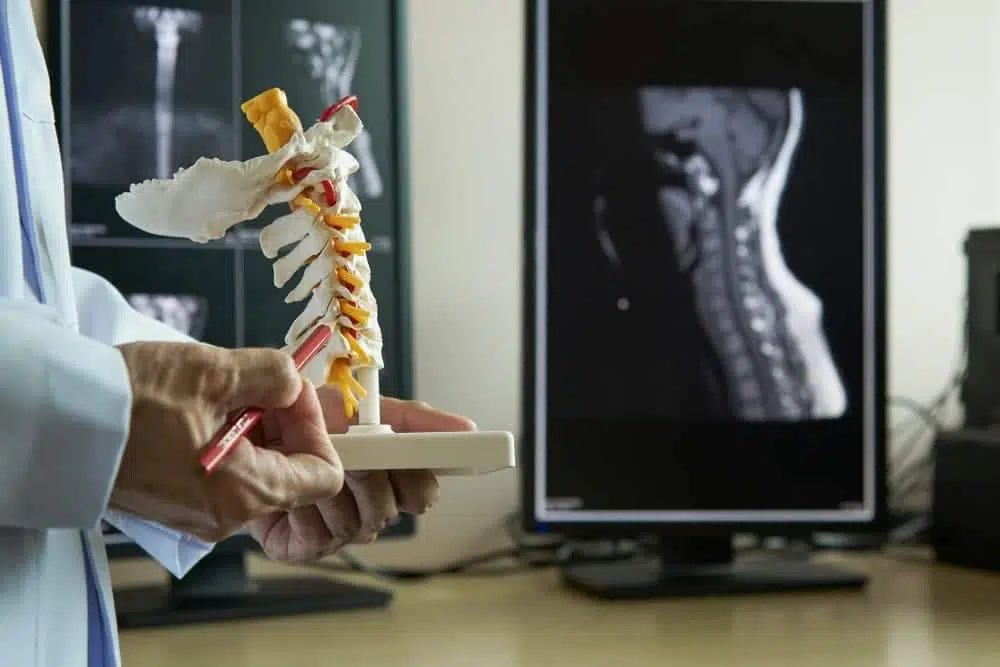Call Now!
Torrance Office: +1 (424) 360-0155

Radiofrequency Rhizotomy (aka Radiofrequency Ablation — RFA) is a revolutionary, non-invasive pain control technique designed to provide patients with long-lasting relief from chronic pain. Our back pain doctors at Rolling Hills Medical use RFA to help those with chronic low back & neck pain related to the degeneration of joints from arthritis.
This non-surgical procedure uses radiofrequency waves to destroy nerve fibers; thus, interrupting the transmission of pain signals before they reach the brain. The radiofrequency waves accomplish this by ablating (i.e., burning) the targeted nerve fibers. Once nerve fiber ablation is complete, pain signal transmission to the brain from the targeted nerve fiber is essentially eliminated.
Besides treating chronic back pain and neck pain, this innovative procedure can be used to treat sacroiliitis (i.e., inflammation of the sacroiliac joint), which frequently results in SI joint pain and spondylosis (arthritis of the spine) as well as pelvic, knee and peripheral nerve pain.
If you suffer from recurrent pain and have previously found relief with nerve block injections, you may be a good candidate for Radiofrequency Rhizotomy because this procedure is 70 to 80 percent effective for patients who have previously found relief following a nerve block.
Individuals who decide to have RFA at Rolling Hills Medical Pain Management Clinic in Torrance receive a variety of benefits, including:
Due to their fast recovery, our patients can participate in a variety of other recreational activities much sooner than they would have been able to if they had undergone a surgical procedure.
On the Day of Your Procedure, Remember to Bring a Driver with You
For the safety of our patients, we do not permit the use of public transportation, or any other type of for-hire transportation, following procedures requiring any form of sedation. Therefore, on the day of your procedure, since patients are not permitted to drive themselves home following their RFA procedures, please arrive at the Rolling Hills Medical Facility with a licensed driver that you trust.
You will Sign the Procedure Paperwork
As with any procedure, you will be given consent forms to sign and asked to list any medications that you are currently taking as well as any allergies you have to medications.
The RFA procedure lasts from 15 to 45 minutes and is followed by a brief recovery period.
Preparing for Your Radiofrequency Rhizotomy:
Once the local anesthetic takes effect, the Radiofrequency Ablation procedure begins.

Using a special instrument called a fluoroscope, which is an X-ray device that allows the doctor to view the area he is treating in real-time on a monitor. The doctor carefully guides a thin, hollow needle into the area causing the patient’s pain. Sometimes, contrast is required to confirm needle location. During this step, patients do experience some discomfort, typically a feeling that is more like pressure than pain.
Once the doctor has the needle in place, more numbing medication is administered: Then, using radiofrequency current passed through the hollow needle, a very small lesion is created on the nerve fibers responsible for transmitting the pain signals to the brain. With this ablation technique, the doctor provides his patients relief from neck pain, SI joint pain, back pain, knee pain, and more.
Patients are monitored for a short period, and then they are released to their driver. Please schedule your follow-up appointment before you leave the office.
Patients generally return to work within 72 hours after their Radiofrequency Rhizotomy procedure. While some patients enjoy immediate pain relief, most experience relief within 10 days’ time; however, there are patients who do not experience relief for up to three weeks. In addition, pain from the procedure itself can last up to 14 days, but is usually caused by residual effects of the ablation procedure or due to muscle spasms.
The pain relief achieved lasts from 9 months to 2 years or more. If the nerve grows back, it usually happens within the first 6 to 12 months; however, this procedure can be repeated.
If you are experiencing pain, there is no need to continue suffering: At Rolling Hills Medical in Torrance, our doctor creates each of his patients a customized treatment plan specifically designed to address his or her pain. At Rolling Hills Medical in Torrance, surgery is always the last resort.
Whether you are dealing with neck pain, back pain, SI joint pain, pelvic pain or knee pain, Rolling Hills Medical in Torrance is here to help. Contact us today at 424-250-8699 to schedule your complimentary consultation. Our office is located at 2557 Pacific Coast Highway, Suite A.